Learn the profound symbolism of the number 4 in the Bible, revealing its representation of universality, creation, and divine order.

What Does the Number 4 Stand for in the Bible
As the saying goes, 'all good things come in fours,' especially when you're exploring the symbolic meanings in the Bible. You've likely noticed the recurring theme of the number 4, from the four corners of the Earth to the four rivers of Eden and the four living creatures. This number isn't just a coincidence; it's steeped in meaning, representing universality, order, and creation among other concepts.
But to truly grasp the depth of what the number 4 symbolizes, you'll need to look beyond its surface appearances. Why, you might ask, does this number hold such significance across different contexts in the biblical narrative? The answer ties together the physical and the divine in ways that might surprise you.
Key Takeaways
- The number 4 in the Bible symbolizes completeness, universality, and the totality of God's creation.
- It is associated with fundamental aspects of the divine order, such as the four Gospels and the four living creatures in prophecy.
- The fourth day of creation highlights its significance, establishing celestial patterns for timekeeping and festivals.
- Number 4 represents stability, foundation, and renewal in faith, reflecting a balance between the material and spiritual realms.
The Four Corners of Earth
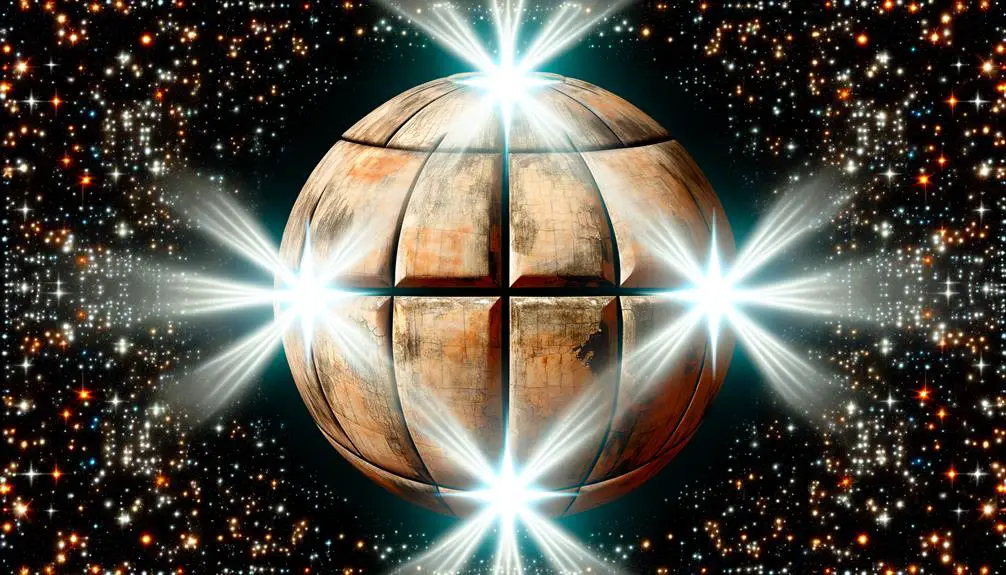
In biblical cosmology, the 'four corners of the earth' symbolize the totality and universality of the created world, suggesting a comprehensive boundary within God's creation. This phrase, deeply embedded in ancient scripture, isn't merely a literal geographical reference but rather a metaphorical expression denoting the extent of God's dominion. It embraces the idea that God's creation is all-encompassing, reaching to the furthest extents in every direction. This concept has been pivotal in shaping cultural interpretations and understandings of the world's geography from a theological perspective.
As you delve deeper into the significance of the 'four corners of the earth', it's essential to consider its implications for global navigation. Historically, this notion influenced early explorers and cartographers who, guided by a blend of spiritual belief and empirical observation, sought to map the world's expanse. They navigated seas and crossed continents with a sense of divine mission, often invoking the idea of the earth's four corners as a symbolic representation of their quest to understand God's creation in its entirety.
Cultural interpretations of the 'four corners of the earth' vary significantly across different societies and epochs, reflecting a rich tapestry of theological and cosmological views. In some cultures, the concept underscores the importance of cardinal directions, imbuing them with spiritual significance and integrating them into religious practices and rituals. This diversity in interpretation highlights the adaptability of biblical metaphors, allowing them to resonate across various contexts and periods.
Analyzing the 'four corners of the earth' thus provides insight into the intersection of faith, geography, and culture, revealing how ancient scriptural concepts have influenced human understanding of the world and our place within it.
Creation Days and Seasons
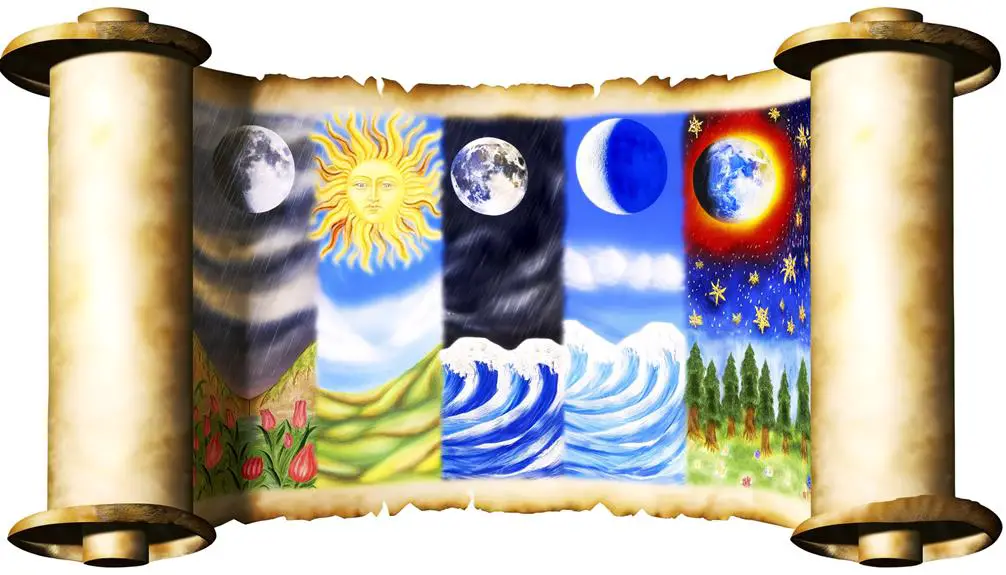
Exploring the biblical narrative, you'll find that the creation days and seasons are pivotal in understanding the structured timeline and divine intentions within the Genesis account. The sequence of creation culminates in the establishment of time itself—days, nights, seasons, and years—symbolizing order and divine timing. This meticulous arrangement underscores the importance of seasonal festivals within the biblical tradition, serving as markers for both agricultural and spiritual cycles.
Creation Day |
Element Created |
Significance |
|---|---|---|
4th |
Sun, Moon, Stars |
Mark seasons, days, and years |
5th |
Sea creatures, Birds |
Fill the waters and skies |
6th |
Land animals, Humans |
Completion of creation |
The fourth day of creation is particularly significant, as it introduces the sun, moon, and stars to mark times and seasons. This not only provides a physical basis for the measurement of time but also a spiritual framework for the observance of seasonal festivals. These celestial bodies were not merely created for illumination but were imbued with the role of signifiers for divine timing, guiding the observance of sacred rites and celebrations.
The establishment of seasons and their corresponding festivals reflects a divine intention to create a rhythm of life that harmonizes human activities with celestial patterns. This rhythm ensures that humanity remains in sync with the divine order, marking times of planting, harvesting, and spiritual reflection. Thus, the creation narrative, with its emphasis on the fourth day, serves as a foundation for understanding the significance of seasonal festivals within the context of divine timing and order.
The Four Rivers of Eden

As you examine the Four Rivers of Eden, consider the detailed descriptions of Eden's waterways, which are crucial for understanding their significance in biblical context.
These rivers' names and courses may offer insights into their symbolic meanings, shedding light on broader theological themes.
Analyzing the interpretations of these symbols can deepen your comprehension of the narrative's complexity and its implications for biblical scholarship.
Eden's Waterways Described
The Bible's description of Eden's waterways introduces us to four rivers that not only nourished the garden but also symbolize profound spiritual truths. These rivers, integral to the garden's geography, played a vital role in its agricultural sustainability.
The text meticulously outlines the flow of these waterways, suggesting their importance in Eden's ecosystem. Their presence underlines the garden's fertility, emphasizing how water was a crucial resource for life and growth.
This depiction isn't just about literal hydration but hints at the broader significance of water in biblical narratives as a source of life and a metaphor for spiritual nourishment. Analyzing Eden's garden geography and the agricultural significance of these rivers, therefore, offers insights into the ancient understanding of the divine-human relationship and the sustenance provided by faith.
Symbolic River Interpretations
Delving into Eden's four rivers reveals layers of symbolism that extend beyond their physical nourishment, offering profound insights into spiritual truths and human existence.
These waterways, more than mere sources of water, are rich with river metaphors and water symbolism. Each river, flowing from a single source, represents the spread of life and divine providence into all corners of the earth.
This imagery not only highlights the interconnectedness of life but also emphasizes the idea that spiritual sustenance, like water, is essential for growth and survival.
Through these rivers, the Bible conveys the message that divine blessings are abundant and accessible to all, urging an understanding of life's profundity and the necessity of spiritual nourishment.
The Four Living Creatures
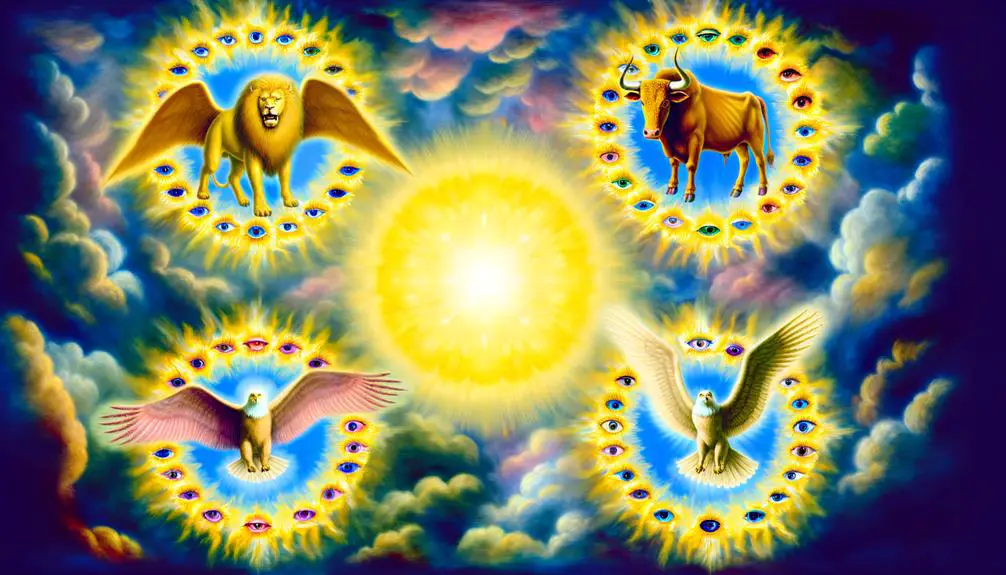
In biblical symbolism, four living creatures represent distinct aspects of creation and divine presence, embodying characteristics that have intrigued scholars and theologians alike. These entities, often associated with heavenly symbolism, carry profound cherubic roles, acting as guardians or bearers of the divine throne. Their descriptions, primarily found in the books of Ezekiel and Revelation, present them as beings with a complex amalgamation of features from different animals, each symbolizing particular virtues or elements of nature.
The first creature resembles a lion, symbolizing strength and royalty, while the second, like an ox, represents servitude and sacrifice. The third, with a face of a man, signifies intelligence and empathy, and the fourth, like an eagle in flight, embodies divine oversight and swiftness. Together, these creatures encapsulate the majesty and omnipotence of the divine, offering a multifaceted view of God's creation that underscores the unity and diversity within the biblical cosmology.
Their roles transcend mere representation. As part of the heavenly court, they worship and proclaim the holiness of God, serving as reminders of His omnipresence and sovereignty. Their continuous praise, 'Holy, holy, holy, is the Lord God Almighty,' signifies an eternal acknowledgment of the divine's unchanging nature.
Analyzing these creatures offers insights into the complex tapestry of biblical theology, where symbols and numbers intertwine to reveal deeper truths about the divine-human relationship and the cosmic order. Their presence in scripture challenges readers to ponder the multifarious ways in which the divine interacts with the world, urging a deeper exploration of biblical symbolism.
The Tetragrammaton: YHWH
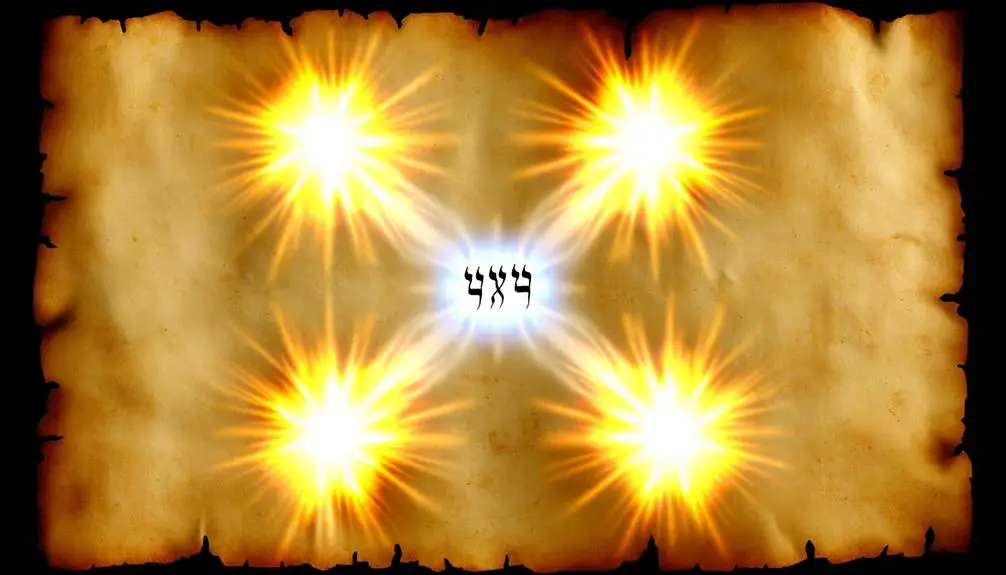
Understanding YHWH, often referred to as the Tetragrammaton, invites you to explore one of the most profound aspects of biblical theology: the sacred and ineffable name of God. This Divine Name, consisting of four Hebrew letters (Yod, Heh, Waw, and Heh), holds a significance that stretches far beyond its brief composition. It's not just a name; it's a statement of existence, meaning 'I Am Who I Am,' thereby reflecting the eternal and unchanging nature of God.
- The Tetragrammaton is considered so sacred that its true pronunciation has been lost over time, with devout Jews using 'Adonai' in its place during prayer.
- It appears over 6,000 times in the Hebrew Bible, signifying its central importance to Jewish spirituality and identity.
- The Sacred Pronunciation of the Tetragrammaton was once known only to the High Priest, who'd utter it once a year on Yom Kippur within the Holy of Holies.
- The preservation of the Tetragrammaton in written form but the absence of its vocalization underscores the Jewish tradition's reverence for the Divine Name.
- Scholars and theologians have proposed various pronunciations, yet none can be confirmed as definitive, preserving the mystery of the Divine Name.
This exploration into the Tetragrammaton highlights a unique intersection between language, spirituality, and the divine. It's a reminder of the power embedded in the Divine Name and the respect commanded by its sacredness—a respect that transcends pronunciation, anchoring itself in the very essence of faith and the shared heritage of a people.
The Four Gospels
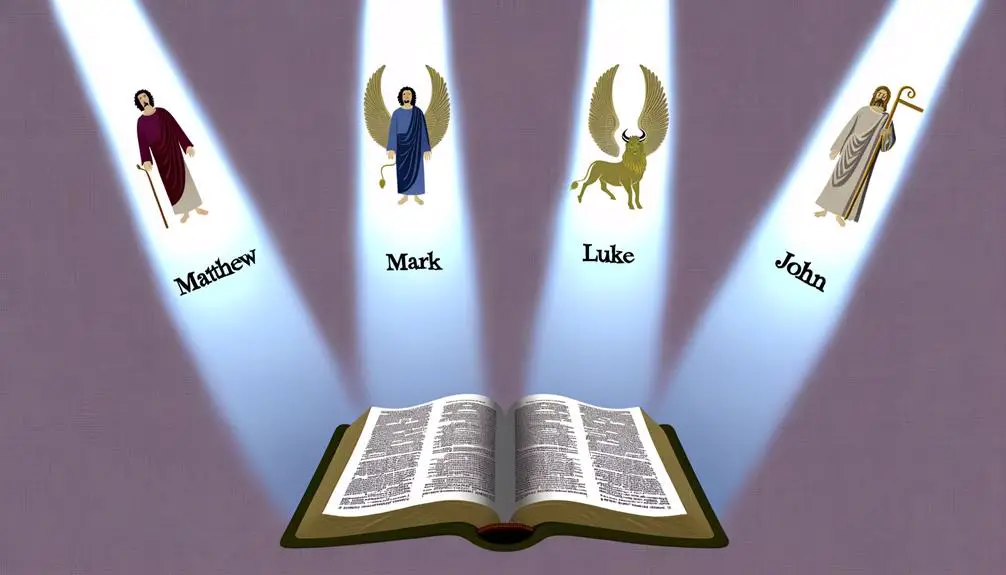
The Four Gospels—Matthew, Mark, Luke, and John—serve as the cornerstone of Christian theology, presenting a multifaceted portrait of Jesus Christ's life, teachings, death, and resurrection. Diving into these texts, you'll uncover unique perspectives from each of the Gospel authors, revealing a comprehensive understanding of Jesus's mission and message. Their accounts harmonize to offer a profound insight into the essence of Christianity, emphasizing the significance of faith, love, and redemption.
A critical examination of the Gospels highlights their distinct narratives and thematic focuses, shaped by the backgrounds and intentions of their respective authors. For instance, parable teachings, a cornerstone of Jesus's pedagogical method, are abundant across the texts, yet each Gospel author selects and interprets these parables in a way that aligns with their theological emphasis.
To engage you further, here's a concise comparison of the Gospels' thematic focuses and their authors:
Gospel |
Main Theme |
|---|---|
Matthew |
Jesus as the fulfillment of Old Testament prophecies |
Mark |
Jesus's actions and miracles |
Luke |
Jesus's compassion and parables |
John |
Jesus's divinity and philosophical teachings |
This table underscores the diversity and depth within the Gospel narratives, reflecting the complex character of Jesus and the multifaceted nature of his teachings. Through their writings, the Gospel authors not only document historical events but also impart timeless wisdom through the powerful medium of parable teachings, offering layers of interpretation that continue to inspire and challenge readers to this day.
Four Major Prophets
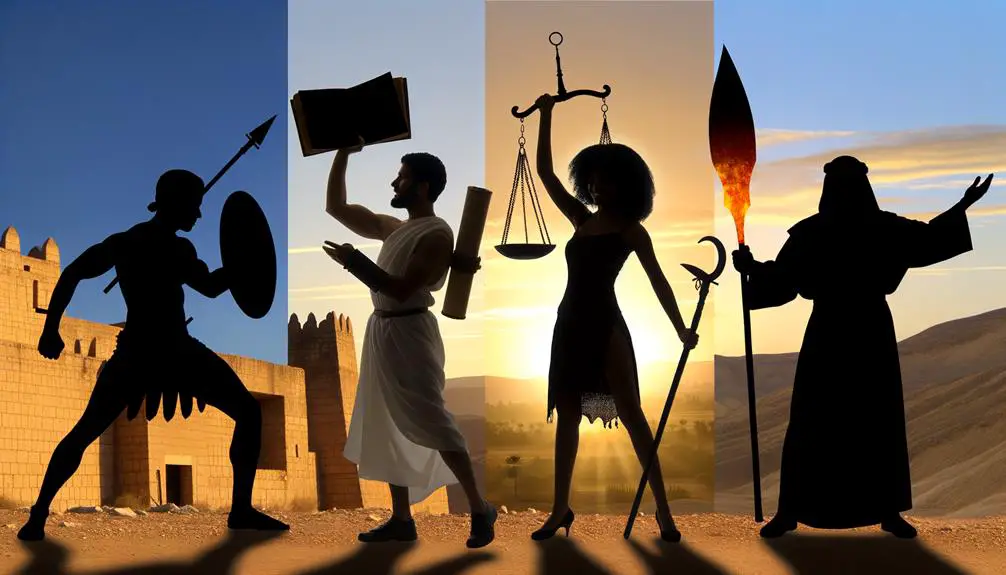
Turning your attention to the Four Major Prophets, you encounter a crucial aspect of biblical literature. These prophets, distinct in their roles and messages, significantly shaped the theological landscape of the Bible.
Their contributions not only delineate a profound impact on the biblical narrative but also offer insights into the divine-human interaction within these sacred texts.
Identifying Four Major Prophets
In biblical scholarship, identifying the Four Major Prophets is crucial for a comprehensive understanding of prophetic literature. These figures are pivotal, not only for their historical context but also for their enduring prophetic significance and contemporary relevance. Their writings and visions offer deep insights into the spiritual, social, and political dynamics of their times, while also providing guidance and wisdom that transcends their historical periods.
- Isaiah: Known for his profound visions and messages of hope and redemption.
- Jeremiah: A prophet of doom, yet with a heart for restoration.
- Ezekiel: His visions and symbolic acts underscore a deep concern for purity and holiness.
- Daniel: Blends apocalyptic visions with tales of personal integrity and divine wisdom.
Prophets' Roles and Messages
Understanding the unique roles and messages of the Four Major Prophets requires delving into the distinct visions and teachings they contributed to biblical literature. Each prophet brought forth messages marked by prophetic accuracy, often delivering divine warnings to the people and leadership of their time.
Their roles transcended mere foretelling; they were divinely appointed voices calling for repentance, justice, and adherence to God's covenant. These prophets, through their deep spiritual insight, unveiled the consequences of the nation's actions, emphasizing the need for a societal return to righteousness.
Their teachings, rich in symbolic and direct communication, served as both a guide and a warning, embodying the complex relationship between divine expectations and human actions.
Impact on Biblical Narrative
The impact of the Four Major Prophets on the biblical narrative significantly alters how readers interpret the themes of justice, repentance, and divine intervention.
- Divine numerology plays a crucial role, with the number four symbolizing universality and completion within the context of divine messages.
- The prophets highlight the Covenant significance, emphasizing the relationship between God and His people.
- Their messages serve as a bridge between divine expectations and human actions, guiding the moral compass of the faithful.
- Through their narratives, the importance of societal justice and individual responsibility is underscored.
- Their prophecies and teachings provide a foundational understanding of divine intervention, shaping the theological framework of the Bible.
This analytical perspective reveals the depth of the prophets' influence on biblical teachings and the overarching narrative.
Symbols of Universality
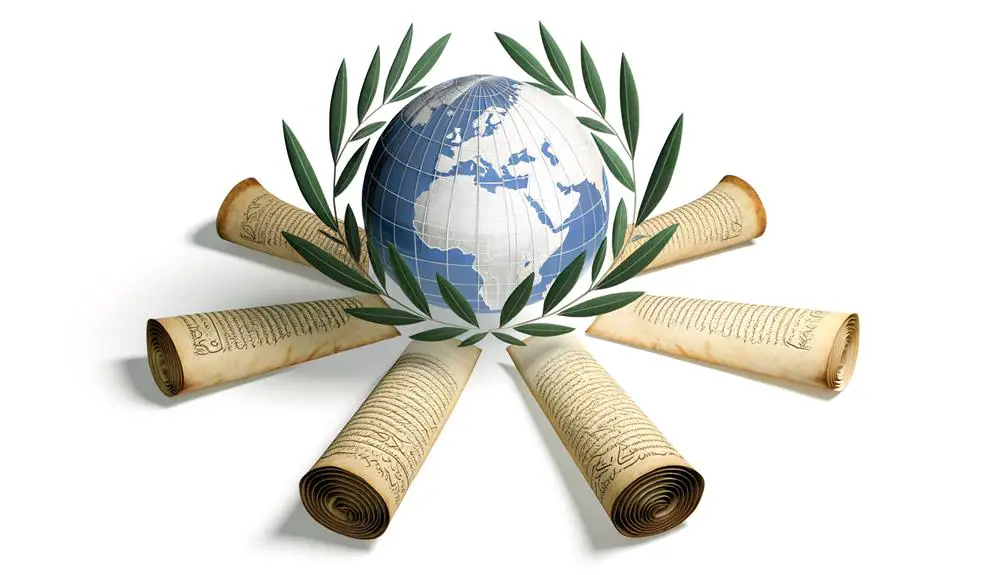
Throughout biblical scripture, the number 4 frequently emerges as a symbol of universality, signifying completeness that spans the earth's four corners. This notion of universality is deeply embedded in the text, reflecting universal patterns and cosmic order that govern the creation and the end times. The number 4 does not stand in isolation; rather, it's intricately linked with the world's physical and spiritual dimensions, offering a glimpse into the divine framework that upholds both the natural and the moral universe.
To better understand how the number 4 symbolizes universality, consider the following table, which highlights its representation in different aspects of biblical teaching:
Aspect |
Example |
Implication |
|---|---|---|
Directions |
North, South, East, West |
Completeness of the earth |
Elements |
Earth, Air, Fire, Water |
Foundations of creation |
Seasons |
Spring, Summer, Fall, Winter |
Cycle of life |
Evangelists |
Matthew, Mark, Luke, John |
Spread of the gospel globally |
These examples underscore the number 4's role in portraying a sense of wholeness and universality across various contexts. From the cardinal directions that map the entirety of the earth's geography to the four seasons that depict the cycle of life, the symbolism of 4 permeates the fabric of both the natural world and the spiritual teachings of the Bible. It serves as a reminder of the cosmic order and the universal patterns that are foundational to understanding the world's creation, sustenance, and eventual renewal.
Frequently Asked Questions
How Does the Number 4 Relate to the Concept of Divine Justice or Judgment in the Bible?
In exploring how the number 4 relates to divine justice or judgment in the Bible, you'll find it significantly represented in the four horsemen analysis, symbolizing conquest, war, famine, and death. These elements collectively portray divine judgment.
Similarly, during the Creation week exploration, the structure and order reflect divine justice in the universe's formation. Both contexts underscore the number 4's deep connection to themes of judgment and the divine order in biblical scripture.
Are There Any Significant Events in the Bible That Occurred on the Fourth Day or in the Fourth Year That Symbolize Its Importance?
You've hit the jackpot!
On the fourth day of Creation, the significance of the number 4 shines brighter than the sun, moon, and stars combined. This pivotal moment introduced the luminaries, serving as seasonal symbols and timekeepers.
Analyzing this through a scholarly lens, it's evident that this event underscores the number's importance in the Bible, embedding a deep, symbolic layer to the fourth day that resonates with divine orchestration.
How Is the Number 4 Used in the Parables or Teachings of Jesus to Convey Deeper Spiritual Lessons?
In Jesus' teachings, you won't find explicit mentions of the number four shaping parable themes.
However, the Four Gospels—Matthew, Mark, Luke, and John—serve as a foundational backbone, indirectly reflecting the number's significance through the varied yet harmonious perspectives they offer on Jesus' life and teachings.
This multiplicity in unity can be seen as echoing deeper spiritual lessons, emphasizing the completeness and universality of Jesus' message.
In Biblical Numerology, How Does the Number 4 Compare or Contrast With Other Significant Numbers Like 7 or 12?
In biblical numerology, the number 4 symbolizes the creation process, setting it apart from other numbers like 7, which represents perfection, or 12, known for covenant symbolism.
While 4 lays the foundation of the world, 7 and 12 build upon it to convey completeness and divine agreements, respectively.
This contrast underscores the unique roles these numbers play in conveying deeper spiritual truths, highlighting the intricate tapestry of biblical symbolism.
Can the Number 4 Be Linked to Specific Biblical Figures or Patriarchs, and What Does It Signify in Their Stories?
You're exploring how the number 4 connects to biblical figures and narratives. It symbolizes universality and completeness, represented by the four winds and four rivers in Eden, illustrating God's creation and provision.
This number doesn't directly link to specific patriarchs but is integral in understanding the biblical cosmos and God's interaction with humanity. It's a foundational element, highlighting God's order in the natural and spiritual realms.
Conclusion
In the tapestry of biblical narrative, the number four weaves through as a symbol of universality and completeness. From the earth's four corners to the foundational Gospels, it serves as a compass guiding the faithful.
The four living creatures and the Tetragrammaton anchor the divine in creation, while the rivers of Eden water the seeds of life. Through this quartet of elements, the Bible constructs a universal harmony, resonating with the cyclical nature of time and the divine order of the cosmos.

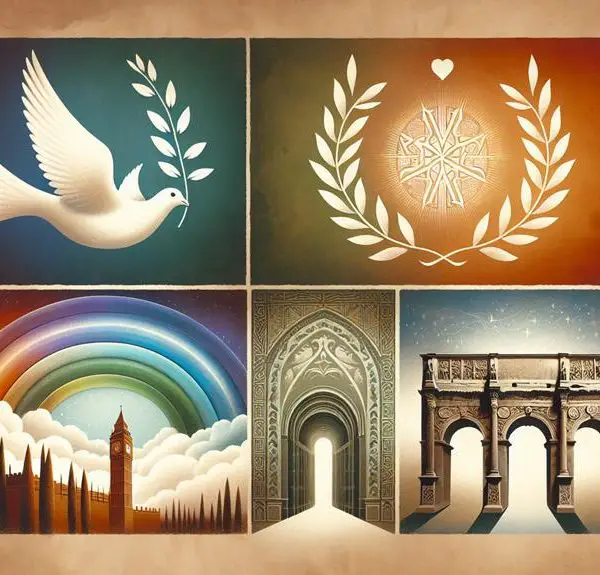
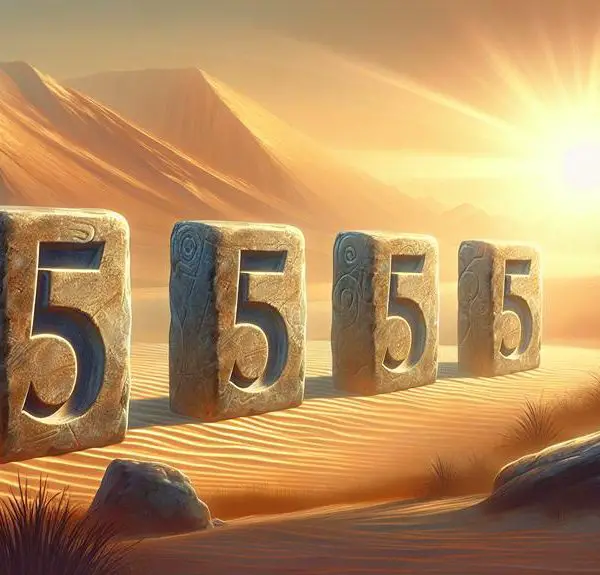
Sign up